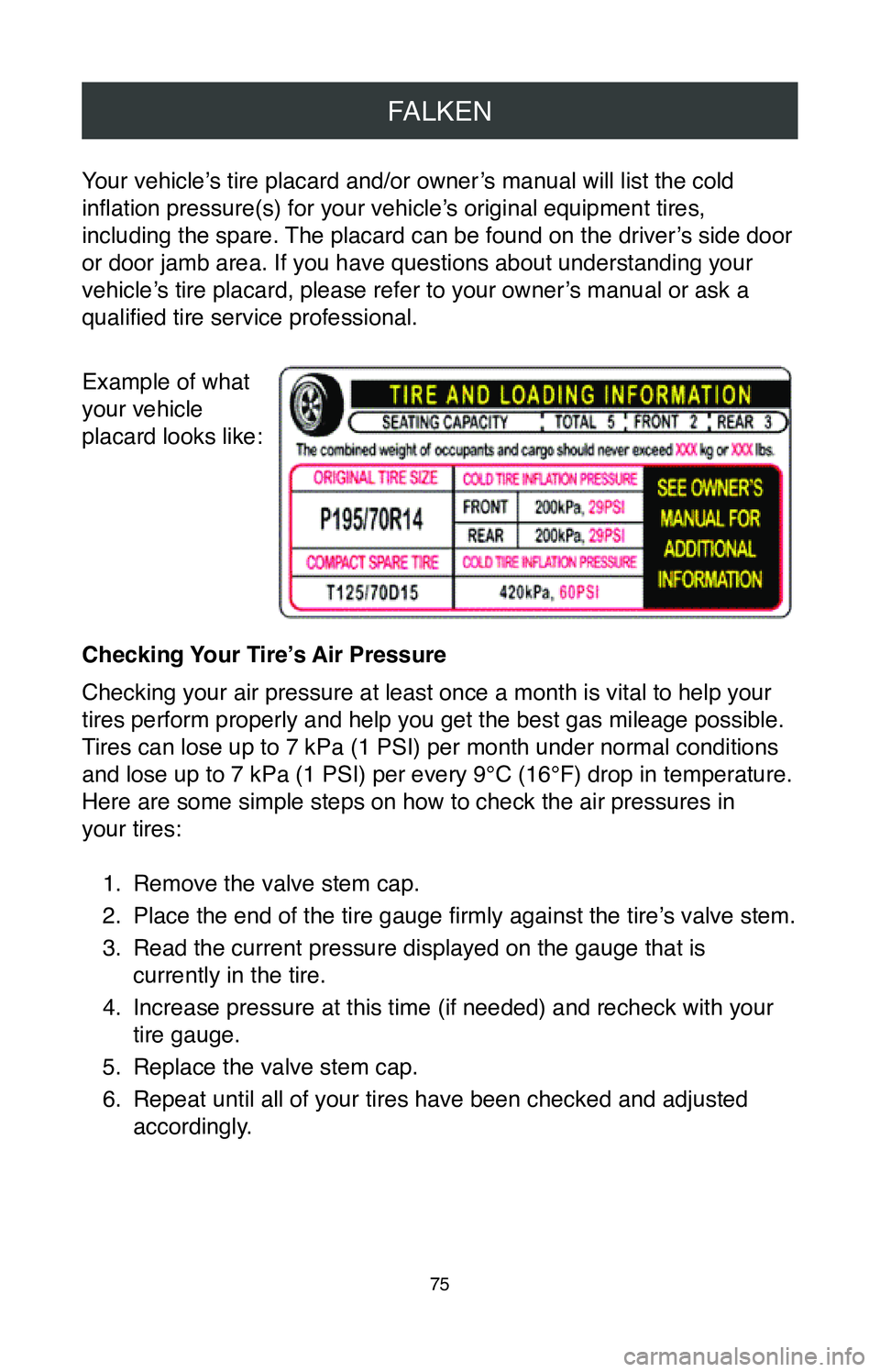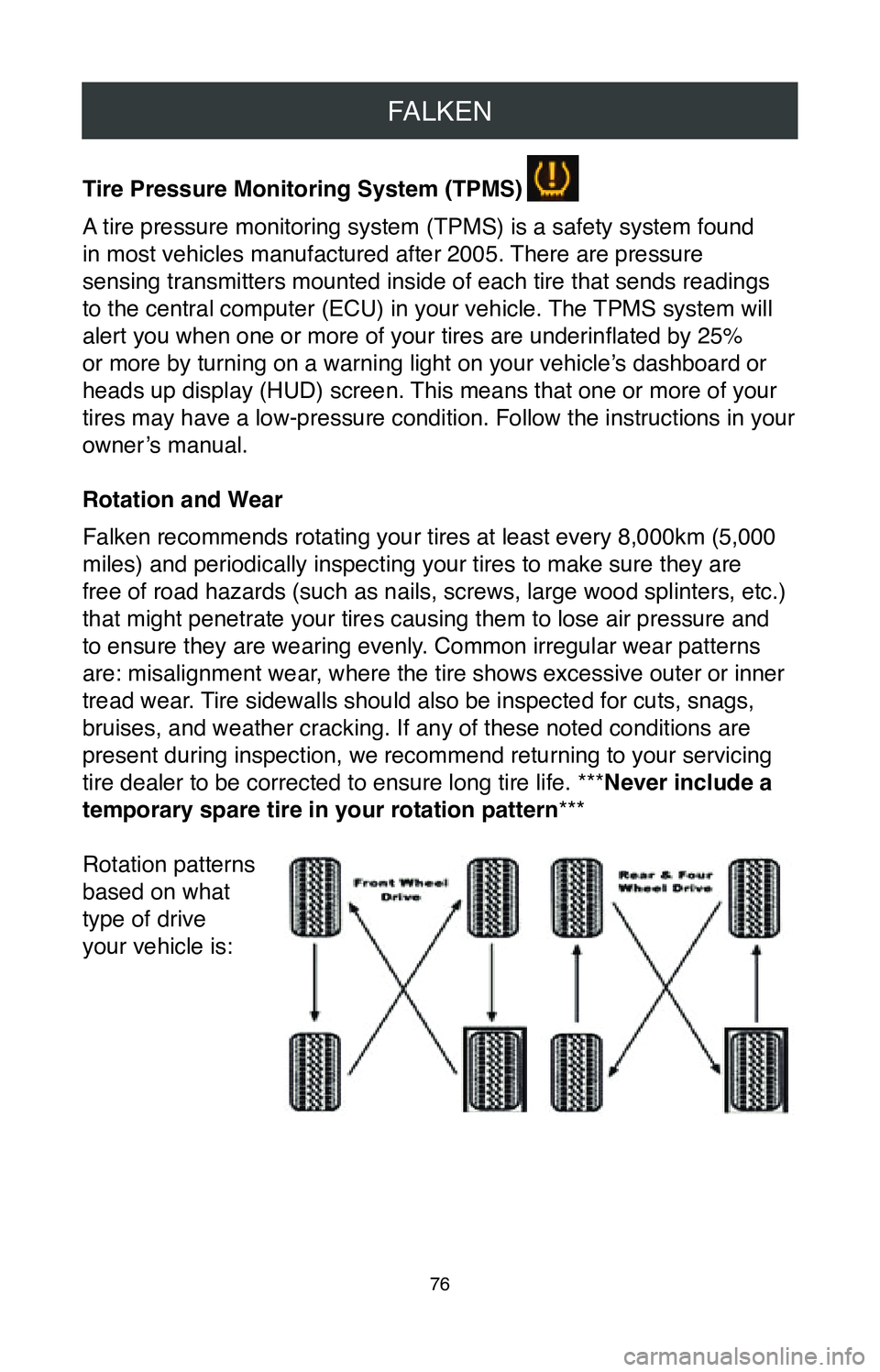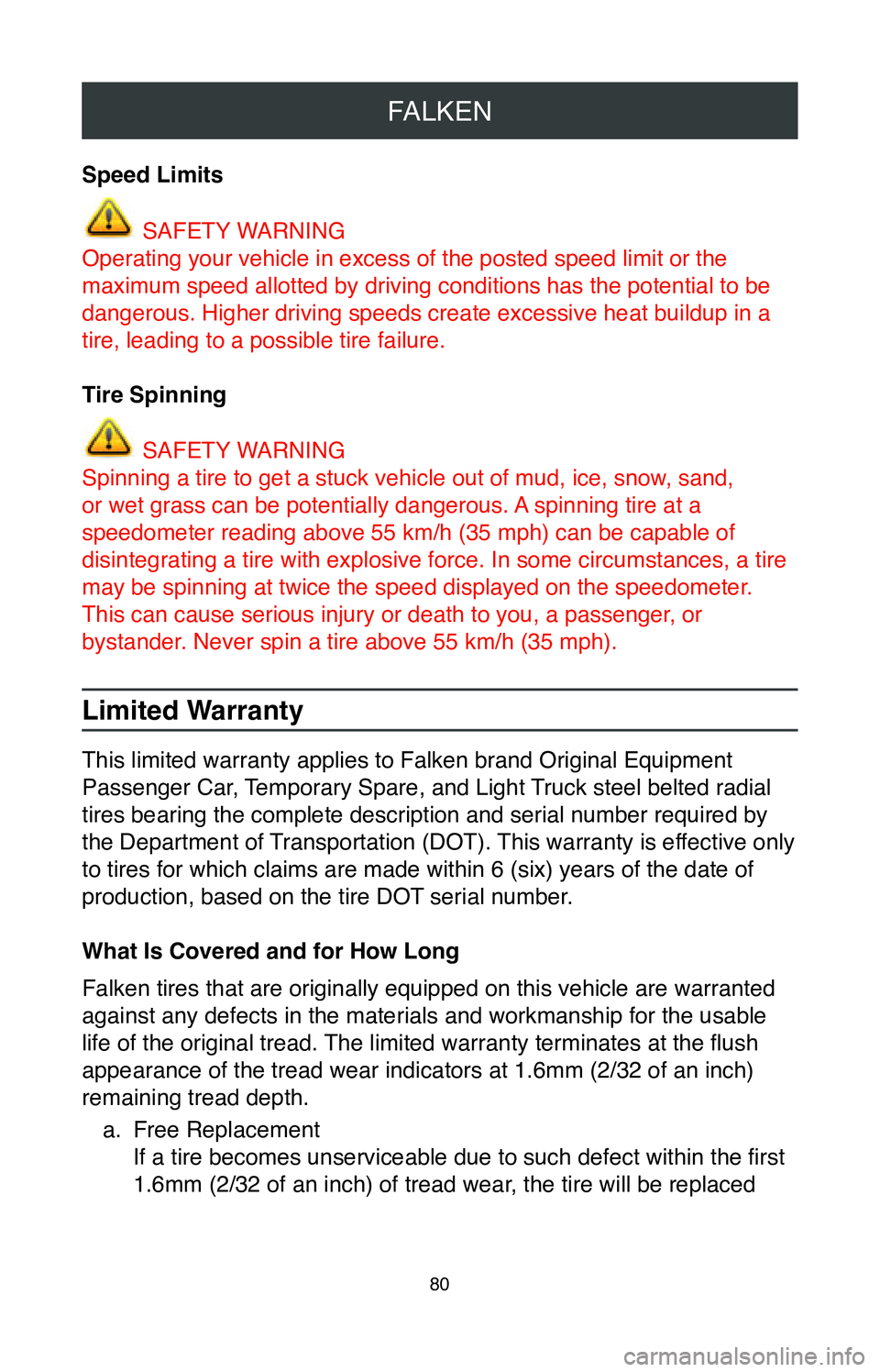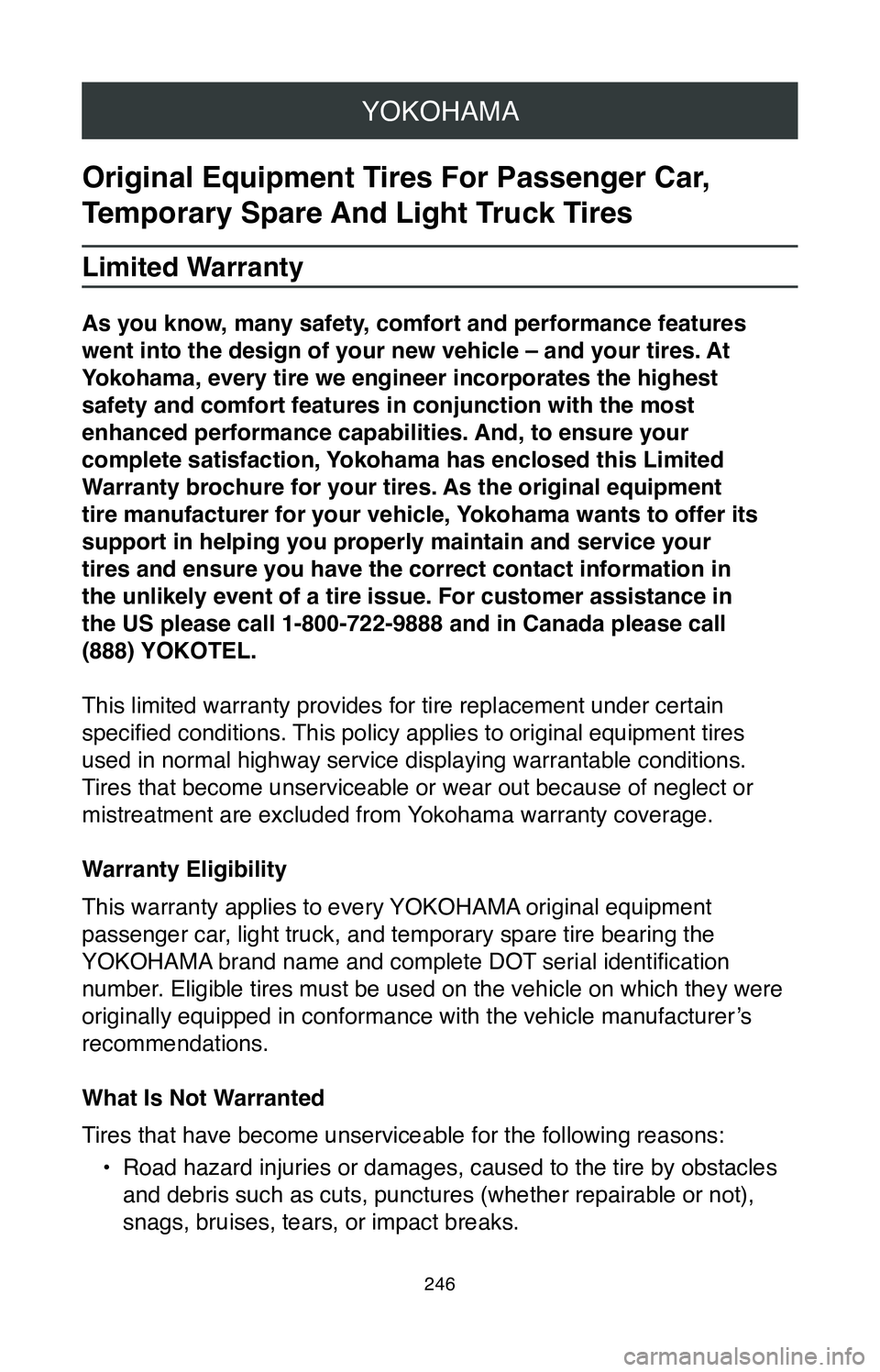display TOYOTA RAV4 HYBRID 2020 Warranties & Maintenance Guides (in English)
[x] Cancel search | Manufacturer: TOYOTA, Model Year: 2020, Model line: RAV4 HYBRID, Model: TOYOTA RAV4 HYBRID 2020Pages: 260, PDF Size: 8.54 MB
Page 77 of 260

FALKEN
75
Your vehicle’s tire placard and/or owner’s manual will list the cold
inflation pressure(s) for your vehicle’s original equipment tires,
including the spare. The placard can be found on the driver’s side door
or door jamb area. If you have questions about understanding your
vehicle’s tire placard, please refer to your owner’s manual or ask a
qualified tire service professional.
Example of what
your vehicle
placard looks like:
Checking Your Tire’s Air Pressure
Checking your air pressure at least once a month is vital to help your
tires perform properly and help you get the best gas mileage possible.
Tires can lose up to 7 kPa (1 PSI) per month under normal conditions
and lose up to 7 kPa (1 PSI) per every 9°C (16°F) drop in temperature.
Here are some simple steps on how to check the air pressures in
your tires:1.
Remove the valve stem cap.
2.
Place the end of the tire gauge firmly against the tire’s valve stem.
3.
Read the current pressure displayed on the gauge that is
currently in the tire.
4.
Increase pressure at this time (if needed) and recheck with your
tire gauge.
5.
Replace the valve stem cap.
6.
Repeat until all of your tires have been checked and adjusted
accordingly.
Page 78 of 260

FALKEN
76
Tire Pressure Monitoring System (TPMS)
A tire pressure monitoring system (TPMS) is a safety system found
in most vehicles manufactured after 2005. There are pressure
sensing transmitters mounted inside of each tire that sends readings
to the central computer (ECU) in your vehicle. The TPMS system will
alert you when one or more of your tires are underinflated by 25%
or more by turning on a warning light on your vehicle’s dashboard or
heads up display (HUD) screen. This means that one or more of your
tires may have a low-pressure condition. Follow the instructions in your
owner’s manual.
Rotation and Wear
Falken recommends rotating your tires at least every 8,000km (5,000
miles) and periodically inspecting your tires to make sure they are
free of road hazards (such as nails, screws, large wood splinters, etc.)
that might penetrate your tires causing them to lose air pressure and
to ensure they are wearing evenly. Common irregular wear patterns
are: misalignment wear, where the tire shows excessive outer or inner
tread wear. Tire sidewalls should also be inspected for cuts, snags,
bruises, and weather cracking. If any of these noted conditions are
present during inspection, we recommend returning to your servicing
tire dealer to be corrected to ensure long tire life. ***Never include a
temporary spare tire in your rotation pattern***
Rotation patterns
based on what
type of drive
your vehicle is:
Page 82 of 260

FALKEN
80
Speed Limits
SAFETY WARNING
Operating your vehicle in excess of the posted speed limit or the
maximum speed allotted by driving conditions has the potential to be
dangerous. Higher driving speeds create excessive heat buildup in a
tire, leading to a possible tire failure.
Tire Spinning
SAFETY WARNING
Spinning a tire to get a stuck vehicle out of mud, ice, snow, sand,
or wet grass can be potentially dangerous. A spinning tire at a
speedometer reading above 55 km/h (35 mph) can be capable of
disintegrating a tire with explosive force. In some circumstances, a tir\
e
may be spinning at twice the speed displayed on the speedometer.
This can cause serious injury or death to you, a passenger, or
bystander. Never spin a tire above 55 km/h (35 mph).
Limited Warranty
This limited warranty applies to Falken brand Original Equipment
Passenger Car, Temporary Spare, and Light Truck steel belted radial
tires bearing the complete description and serial number required by
the Department of Transportation (DOT). This warranty is effective only
to tires for which claims are made within 6 (six) years of the date of
production, based on the tire DOT serial number.
What Is Covered and for How Long
Falken tires that are originally equipped on this vehicle are warranted \
against any defects in the materials and workmanship for the usable
life of the original tread. The limited warranty terminates at the flush
appearance of the tread wear indicators at 1.6mm (2/32 of an inch)
remaining tread depth.
a.
Free Replacement
If a tire becomes unserviceable due to such defect within the first
1.6mm (2/32 of an inch) of tread wear, the tire will be replaced
Page 248 of 260

YOKOHAMA
246
Original Equipment Tires For Passenger Car,
Temporary Spare And Light Truck Tires
Limited Warranty
As you know, many safety, comfort and performance features
went into the design of your new vehicle – and your tires. At
Yokohama, every tire we engineer incorporates the highest
safety and comfort features in conjunction with the most
enhanced performance capabilities. And, to ensure your
complete satisfaction, Yokohama has enclosed this Limited
Warranty brochure for your tires. As the original equipment
tire manufacturer for your vehicle, Yokohama wants to offer its
support in helping you properly maintain and service your
tires and ensure you have the correct contact information in
the unlikely event of a tire issue. For customer assistance in
the US please call 1-800-722-9888 and in Canada please call
(888) YOKOTEL.
This limited warranty provides for tire replacement under certain
specified conditions. This policy applies to original equipment tires
used in normal highway service displaying warrantable conditions.
Tires that become unserviceable or wear out because of neglect or
mistreatment are excluded from Yokohama warranty coverage.
Warranty Eligibility
This warranty applies to every YOKOHAMA original equipment
passenger car, light truck, and temporary spare tire bearing the
YOKOHAMA brand name and complete DOT serial identification
number. Eligible tires must be used on the vehicle on which they were
originally equipped in conformance with the vehicle manufacturer ’s
recommendations.
What Is Not Warranted
Tires that have become unserviceable for the following reasons:
•
Road hazard injuries or damages, caused to the tire by obstacles
and debris such as cuts, punctures (whether repairable or not),
snags, bruises, tears, or impact breaks.